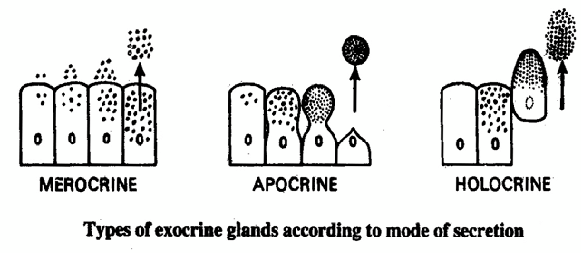Glands
- A cell, tissue or organ which secretes specific chemical secretion is known as a gland.
- The glands develop from the epithelium tissues.
- The glands are classified in differ ways.
1. SITE OF SECRETION -
- According to the site where secretion is released, the glands are of three types : exocrine, endocrine, heterocine
A. EXOCRINE GLANDS -
- Their secretions on the epithelial surface, direcly or through ducts are called exocrine glands (= externally secreting glands).
e.g. these include salivary glands, gastric glands, intestinal glands, tear glands, sweat glands, oil glands, mammary glands, etc.
(i) TUBULAR GLANDS
- The secetory portion is tube-like. They are of the following types. (a) Simple straight tubular glands
e.g. Crypts of Lieberkuhn = (a type of intestinal glands) in the human ileum and glands present in the male frog's nupial pads.
(b) Simple coiled tubular glands - e.g. Sweat (= sudoriferous) glands of mammalian skin. (c) Simple branched tubular glands
e.g. Brunner's glands (= a type of inestinal glands) of human intestine, gastric glands, uterine glands and sweat glands of human armpits.
(d) Compound tubular glands - e.g. Milk glands of egg laying mammals, and salivary glands.
(ii) SACCULAR GLANDS (= ALVEOLAR OR ACINOUS OR ACINAR GLANDS) -
- The secretory portions of these glands are flask shaped called alveolus or acinus.
- They are of the following types.
(a) Simple saccular glands - e.g. Cutaneous (mucous) glands of frog. (b) Simple branched saccular glands - e.g. Oil (sebaceous) glands.
(c) Compound saccular glands - e.g. ® Human milk glands, sublingual and sub mandibular salivary glands and exocrine part of pancreas.
(d) Compound tubulo-saccular glands.
The secretory portion is both tubular and flask like,
e.g., pancrese, functional mammary glands, Cowper's glands in males and Bartholian's glands in females
B. ENDOCRINE GLANDS (= DUCTLESS GLANDS) -
- Their secretions are called hormones which are poured directly into the blood and lymph.
- The blood and lymph carry hormones to the target organs.
- Examples thyroid, parathyroids, hypothalamus, pitutary, adrenals, thymus, etc.
C. HETEROCRINE GLANDS -
- They have both exocrine part and endocrine part.
- The former sends its secretion by way of a duct and the latter releases its secretion directly into the blood and lymph.
- Pancreas and gonads (testes and ovaries) are heterocrine glands.
2. MODE OF SECRETION -
- On the basis of the mode of releasing the secretion, the glands are of three types :-
(i) Merocrine glands
- In these glands, the secretion is discharged by the cells by simple diffusion, so that there is no loss of cells or their parts. E.g. goblet cells, most sweat glands, salivary glands, intestinal glands.
(ii) Apocrine glands
- In these glands, secretory products, accumulate in apical part of the cells.
- Later, this part breaks off from the cell and is discharged as secretion
- e.g., mammary glands and some sweat glands.
(iii) Holocrine glands
- In these glands, an entire cell, when filled with secretory products, distintegrates and is discharged as a part of secretion, e.g., sebaceous glands.

